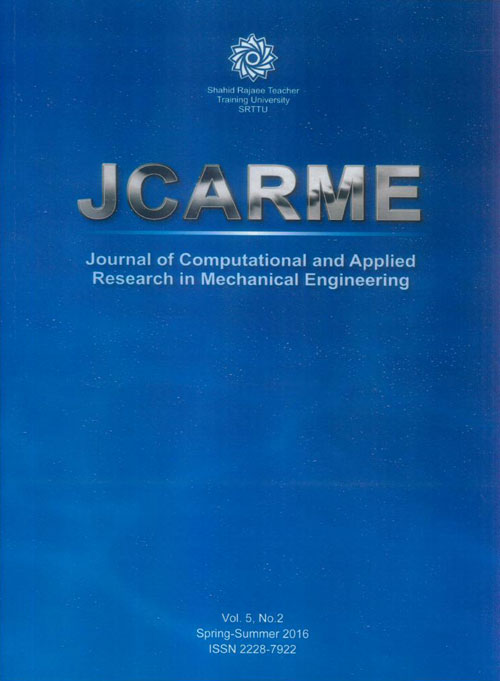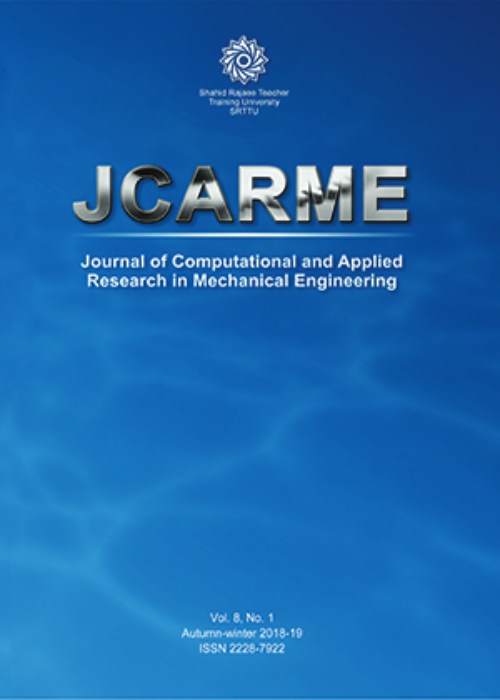فهرست مطالب

Journal of Computational and Applied Research in Mechanical Engineering
Volume:5 Issue: 2, Spring 2016
- تاریخ انتشار: 1395/02/02
- تعداد عناوین: 7
-
-
Pages 83-95An analytical investigation is conducted to study the unsteady free convection heat and mass transfer flow through a non-homogeneous porous medium with variable permeability bounded by an infinite porous vertical plate in slip flow regime while taking into account the thermal radiation, chemical reaction, the Soret number, and temperature gradient dependent heat source. The flow is considered under the influence of magnetic field applied normal to the flow. Approximate solutions for velocity, temperature, and concentration fields are obtained using perturbation technique. The expressions for skin-friction, rate of heat transfer, and rate of mass transfer are also derived. The effects of various physical parameters, encountered in the problem, on the velocity field, temperature field, and concentration field are numerically shown through graphs, while the effects on skin-friction, rate of heat, and mass transfer are numerically discussed by tables.Keywords: Free convection, Chemical reaction, The Soret number, non, homogeneous porous medium, Temperature gradient heat source, Radiation
-
Pages 97-109Laser forming is a thermal forming process which uses laser beam irradiation to produce the desired final forms. In this article, the effect of temperature gradient across Al 6061-T6 aluminum sheets on bending angle is studied. Input parameters including laser power, scan velocity, beam diameter, and sheet thickness are the effective process parameters which influence the temperature gradient. Thus, a set of 81 numerical simulations based on a full factorial design with varying parameters is carried out and temperature gradient across the sheet thickness is measured. Effects of each input parameter on temperature gradient are determined using analysis of variance. Also, an equation is derived which predicts the temperature gradient for any arbitrary input parameter. The validity of the equation is done by comparing actual and predicted results. Numerical simulation is validated by experimental tests, which show a very close agreement. Finally, the effects of temperature gradient for three different sheet thicknesses on a final bending angle are derived. Results demonstrate that increase in temperature gradient across sheet thickness leads to increase in bending angle.Keywords: Laser forming process, Aluminum alloy sheet, Temperature gradient, Bending angle, Process parameters
-
Pages 111-126The main purpose of this work is to investigate the porous medium and diffusion-thermo effects on unsteady combined convection magneto hydrodynamics boundary layer flow of viscous electrically conducting fluid over a vertical permeable surface embedded in a high porous medium, in the presence of first order chemical reaction and thermal radiation. The slip boundary condition is applied at the porous interface. A uniform Magnetic field is applied normal to the direction of the fluid flow. The non-linear coupled partial differential equation are solved by perturbation method and obtained the expressions for concentration, temperature and velocity fields. The rate of mass transfer in terms of Sherwood number , the rate of heat transfer in terms of Nusselt number and the Skin friction coefficient are also derived. The Profiles of fluid flow quantities for various values of physical parameters are presented and analyzed. Profiles of fluid flow quantities for various values of physical parameters are presented and analyzed.Keywords: Diffusion, thermo effect, Thermal radiation, Chemical reaction, Magnetic fields
-
Pages 127-136In the design of heat exchangers, it is necessary to determine the heat transfer rate between hot and cold fluids in order to calculate the overall heat transfer coefficient and the heat exchanger efficiency. Heat transfer rate can be determined by inverse methods. In this study, the unknown space-time dependent heat flux imposed on the wall of a heat exchanger internal tube is estimated by applying an inverse method and simulated temperature measurements at the specified points in the flow field. It is supposed that no prior information is available on the variation of the unknown heat flux function. Variable metric method which belongs to the function estimation approach is utilized to predicate the unknown function by minimizing an objective function. Four versions of the presented inverse method, named DFP, BFGS, SR1, and Biggs, are used to solve the problem and the results obtained by each version are compared. The estimation of the heat flux depends on the location of the sensor and the uncertainties associated with temperature measurements. The influence of each factor is investigated in this paper. Results show that variable metric method is a rapid and precise technique for estimating unknown boundary conditions in inverse heat convection problems.Keywords: Inverse heat transfer, Variable metric method, Heat exchanger, Unknown heat flux
-
Pages 137-145Heat transfer from the internal surfaces of a vertical pipe to the adjacent air gives rise to the air flow establishment within the pipe. With the aim of optimizing the convective air flow rate in a vertical pipe, the details of the flow and thermal fields were investigated in the present study. Conservation equations of mass, momentum, and energy were solved numerically using simple implicit forward-marching finite difference scheme for a two-dimensional axis-symmetric flow. In order to evaluate and optimize the air flow rate passing through the pipe, the position and intensity of the wall heat flux were altered when the total employed heat transfer rate was constant. Based on the results of the numerical analysis, relatively more air flow rate was achieved when more intensified heat flux was employed at the lowest part of the vertical pipe. This finding was then validated using a simple experimental setup. The results of the present study could be useful in the design and application of buoyancy-assisted natural ventilation systems.Keywords: Natural ventilation, vertical pipe, wall heat flux
-
Pages 147-160In this paper, the laminar incompressible flow equations are solved by an upwind least-squares meshless method. Due to the difficulties in generating quality meshes, particularly in complex geometries, a meshless method is increasingly used as a new numerical tool. The meshless methods only use clouds of nodes to influence the domain of every node. Thus, they do not require the nodes to be connected to form a mesh and decrease the difficulty of meshing, particularly around complex geometries. In the literature, it has been shown that the generation of points in a domain by the advancing front technique is an order of magnitude faster than the unstructured mesh for a 3D configuration. The NavierStokes solver is based on the artificial compressibility approach and the numerical methodology is based on the higher-order characteristic-based (CB) discretization. The main objective of this research is to use the CB scheme in order to prevent instabilities. Using this inherent upwind technique for estimating convection variables at the mid-point, no artificial viscosity is required at high Reynolds number. The Taylor least-squares method was used for the calculation of spatial derivatives with normalized Gaussian weight functions. An explicit four-stage Runge-Kutta scheme with modified coefficients was used for the discretized equations. To accelerate convergence, local time stepping was used in any explicit iteration for steady state test cases and the residual smoothing techniques were used to converge acceleration. The capabilities of the developed 2D incompressible Navier-Stokes code with the proposed meshless method were demonstrated by flow computations in a lid-driven cavity at four Reynolds numbers. The obtained results using the new proposed scheme indicated a good agreement with the standard benchmark solutions in the literature. It was found that using the third order accuracy for the proposed method could be more efficient than its second order accuracy discretization in terms of computational time.Keywords: Incompressible laminar artificial compressibility, Least, squares meshless method, Characteristic based scheme
-
Pages 161-172In this paper, a comparison is made between direct and indirect perturbation approaches to solve the non-linear vibration equations of a piezoelectrically actuated cantilever microbeam. In this comparison, the equation of motion is considered according to Euler-Bernoulli theory with considering the non-linear geometric and inertia terms resulted from shortening effect. In the direct perturbation approach, the multiple scales method is directly applied to the partial differential equation of motion. In the indirect approach, the multiple scales perturbation technique is applied to the discretized equation of motion. It is shown that, if the equation of motion is discretized using one non-uniform microbeam mode shape as a comparison function, then the results of indirect perturbation approach will be identical to those of the direct perturbation approach. Moreover, it is observed that discretization using one uniform microbeam mode shape as a comparison function results in a different output. The concept of non-uniform microbeam mode shape is the linear mode shape of the microbeam by considering the geometric and inertia effects of the piezoelectric layer.Keywords: Direct perturbation, Indirect perturbation, Microcantilever, Nonlinear vibration, Shortening effect, Piezoelectric


